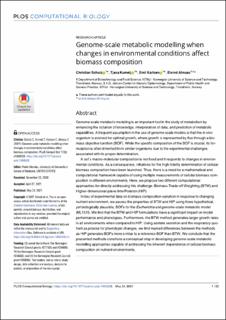| dc.contributor.author | Schulz, Christian | |
| dc.contributor.author | Kumelj, Tjasa | |
| dc.contributor.author | Karlsen, Emil | |
| dc.contributor.author | Almaas, Eivind | |
| dc.date.accessioned | 2022-02-15T08:57:28Z | |
| dc.date.available | 2022-02-15T08:57:28Z | |
| dc.date.created | 2021-06-11T16:10:34Z | |
| dc.date.issued | 2021 | |
| dc.identifier.citation | PLoS Computational Biology. 2021, 17 (5), . | |
| dc.identifier.issn | 1553-734X | |
| dc.identifier.uri | https://hdl.handle.net/11250/2978978 | |
| dc.description.abstract | Genome-scale metabolic modeling is an important tool in the study of metabolism by enhancing the collation of knowledge, interpretation of data, and prediction of metabolic capabilities. A frequent assumption in the use of genome-scale models is that the in vivo organism is evolved for optimal growth, where growth is represented by flux through a biomass objective function (BOF). While the specific composition of the BOF is crucial, its formulation is often inherited from similar organisms due to the experimental challenges associated with its proper determination.
A cell’s macro-molecular composition is not fixed and it responds to changes in environmental conditions. As a consequence, initiatives for the high-fidelity determination of cellular biomass composition have been launched. Thus, there is a need for a mathematical and computational framework capable of using multiple measurements of cellular biomass composition in different environments. Here, we propose two different computational approaches for directly addressing this challenge: Biomass Trade-off Weighting (BTW) and Higher-dimensional-plane InterPolation (HIP).
In lieu of experimental data on biomass composition-variation in response to changing nutrient environment, we assess the properties of BTW and HIP using three hypothetical, yet biologically plausible, BOFs for the Escherichia coli genome-scale metabolic model iML1515. We find that the BTW and HIP formulations have a significant impact on model performance and phenotypes. Furthermore, the BTW method generates larger growth rates in all environments when compared to HIP. Using acetate secretion and the respiratory quotient as proxies for phenotypic changes, we find marked differences between the methods as HIP generates BOFs more similar to a reference BOF than BTW. We conclude that the presented methods constitute a conceptual step in developing genome-scale metabolic modelling approaches capable of addressing the inherent dependence of cellular biomass composition on nutrient environments. | |
| dc.language.iso | eng | |
| dc.publisher | PLoS - Public Library of Science | |
| dc.rights.uri | https://creativecommons.org/licenses/by/4.0/ | |
| dc.title | Genome-scale metabolic modelling when changes in environmental conditions affect biomass composition | |
| dc.type | Peer reviewed | |
| dc.type | Journal article | |
| dc.description.version | publishedVersion | |
| dc.source.pagenumber | 22 | |
| dc.source.volume | 17 | |
| dc.source.journal | PLoS Computational Biology | |
| dc.source.issue | 5 | |
| dc.identifier.doi | 10.1371/journal.pcbi.1008528 | |
| dc.identifier.cristin | 1915346 | |
| dc.relation.project | Norges forskningsråd: 269084 | |
| dc.relation.project | Norges forskningsråd: 271585 | |
| dc.relation.project | Norges forskningsråd: 248885 | |
| dc.relation.project | Norges forskningsråd: 294605 | |
| dc.rights.license | https://creativecommons.org/licenses/by/4.0/ | |
| cristin.ispublished | true | |
| cristin.fulltext | original | |
| cristin.qualitycode | 2 | |

